Attention Users: For systematic learning, please prefer to check the index page of the MCQs in Forensic Ballistics.
1. Hammer marks are:
- Striation marks
- Cut marks
- Compression marks
- None of the above
Answer and Explanation
Answer: (3) Compression marks
Explanation: As the hammer has a broad striking area, it creates a compression mark to the surface.
2. Compression tool marks are produced by:
(i) Hammer (ii) Cutter (iii) Saw (iv) Firing pin
- (i) and (iv) are correct
- (ii) and (iii) are correct
- (i), (ii) and (iv) are correct
- (ii) and (iv) are correct
Answer and Explanation
Answer: (1) By Hammer and firing pin
Explanation: Compression tool marks are produced by tools that have a broader face surface area such as a hammer.
3. The matching of compression tool marks is based on:
- Line matching
- Contour matching
- Depth matching
- None of these
Answer and Explanation
Answer: (2) Contour matching
Explanation: In the forensic analysis of tool marks, the contour matching is the edge-by-edge fitting (or sitting in space) of the pieces of sample like a jigsaw puzzle.
4. Which of the following is not the type of tool mark?
- Striation marks
- Compression marks
- Hackle marks
- Combination of striation and compression marks
Answer and Explanation
Answer: (3) Hackle marks
Explanation: Hackle mark is a line on the crack surface running parallel to the direction of fracture and can be used to match two pieces of glass.
5. In firing case, muzzle pattern is found in
- Contact fire
- Firing from 4 ft
- Firing from 8 ft
- Long distance firing
Answer and Explanation
Answer: (1) Contact fire
Explanation: Muzzle pattern is always being found over the skin surface in contact firing.
6. Match the following:
| List-I | List-II |
| (a) Single action striation mark | (i) Hammer |
| (b) Punch mark | (ii) Pliers |
| (c) Repeated action tool marks | (iii) Screw drive |
| (d) Cutting mark of wire | (iv) Drill |
| (a) | (b) | (c) | (d) | |
| 1. | (iii) | (ii) | (i) | (iv) |
| 2. | (iii) | (i) | (iv) | (ii) |
| 3. | (iv) | (iii) | (i) | (ii) |
| 4. | (ii) | (iv) | (i) | (iii) |
Answer
Answer: (2) (iii), (i), (iv), (ii)
7. Drill marks are
- Single action striation mark
- Compression mark
- Repeated action striation mark
- Mixed marks
Answer
Answer: (3) Repeated action striation mark
8. The following substance can be used for casting of the tool marks:
- Plaster of Paris
- Wax
- Alumina
- Woods metal
Answer and Explanation
Answer: (4) Woods metal
Explanation:
->In woods metal casting, alloys of soft metals such as lead, bismuth, and tin are used.
-> They replicate the microscopic grooves that are present on a tool’s surface without making any damage to their surface.
9. The following materials are most suitable for casting of tool marks:
a. Wood’s metal b. Vinylite c. Plaster of Paris d. Wax
- a and b are correct
- a and c are correct
- b and c are correct
- c and d are correct
Answer and Explanation
Answer: (1) a and b are correct
Explanation:
-> In woods metal casting, with the use of soft metals such as lead, one can even replicate the microscopic grooves that are present on a tool’s surface without making any damages to the surface.
-> An accurate cast of tool marks can be made with the use of plastic such as Vinylite (Science in Crime Detection – Page 57).
10. Variation of ________ in tool angle may cause a significant influence on the matching of the questioned and standard tool mark of the same tool.
- 5°
- 10°
- 20°
- Above 20°
Answer
Answer: (2) 10°
11. An indentation mark is caused by a tool when it is pressed upon a surface
- With continuous impact of low angle in motion
- With non-continuous impact in motion
- With sliding motion
- Without sliding motion
Answer and Explanation
Answer: (4) Without sliding motion
Explanation: An indentation mark is produced when a hard object comes into forcible contact with another (less hard) surface and no lateral movement occurs at the time of contact.
12. Hammerhead against gypsum board will create
- Striation marks
- Saw and drill marks
- Extractor marks
- Compression marks
Answer
Answer: (4) Compression marks
13. The criterion for positive matching of striation tool marks is:
- 25% Ridge matching
- 40% Ridge matching
- 50% Ridge matching
- 60% Ridge matching
Answer and Explanation
Answer: (4) 60% Ridge matching
Explanation: The general criterion for positive matching of striation tool marks is more than half and in this case, 60% ridge matching fits the answer.
14. Erased number on metal can be restored by:
- Rubbing
- Filing
- Steaming
- Chemical etching
Answer and Explanation
Answer: (4) Chemical etching
Explanation: Chemical etching uses reagents to restore the erased number. The two most common etching chemicals are thiocyanic acid and yellow ammonium sulfide.
15. Mechanical erasures can be deciphered by the following method:
- Ammonium sulphide
- Ordinary photography
- Photography in reflected light
- Dyes
Answer
Answer: (1) Ammonium sulphide
Explanation: The use of ammonium sulfide as restoration may only work in the case of “iron-nutgall inks” which contain a considerable quantity of iron salt.
Jump to the index page of the Forensic Ballistic MCQs.
